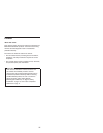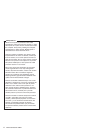
Attention: A customized setup configuration (other than
default settings) may exist on the computer you are
servicing. Running Automatic Configuration may alter those
settings. Note the current configuration settings (using the
View Configuration option) and verify that the settings are
in place when service is complete.
Hard Disk Drive Replacement Strategy
Always try to run a low-level format before replacing a hard
disk drive.
Attention: The drive startup sequence in the computer
you are servicing might have been changed. Be extremely
careful during write operations such as copying, saving, or
formatting. Data or programs can be over-written if you
select an incorrect drive.
How to Use Error Messages
Use the error codes displayed on the screen to diagnose
failures. If more than one error code is displayed, begin the
diagnosis with the first error code. The cause of the first
error code can result in false error codes being displayed.
If no error code is displayed, see if the error symptom is
listed in the Symptom-to-FRU Index for the computer you
are servicing.
How to Read POST Error Messages
POST error messages are displayed on the screen as
three, four, five, or eight digits. The error messages that
can be displayed as shorter POST messages are
highlighted in this index. Some digits will represent
different information for SCSI errors versus non-SCSI
errors.
All SCSI devices are set to a different SCSI ID. Duplicate
SCSI ID settings can generate a false error message. Use
the SCSI ID to determine whether the error message is
coming from an internal or an external device.
Drive and Diskette Compatibility Matrix
The following table provides identification information for
3.5-inch drives.
Diskette Drive Identifying Mark
3.5-Inch - 1.44MB 1.44 on the eject button
3.5-Inch - 2.88MB 2.88 on the eject button
The following table provides compatibility information for
3.5-inch diskettes and 3.5-inch diskette drives.
2 ThinkPad R30/R31 HMM


















